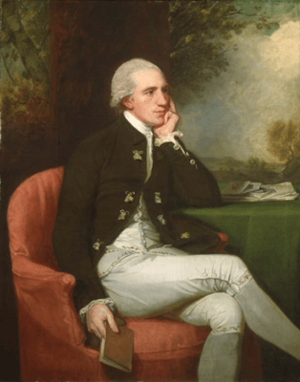William Petrie facts for kids
Quick facts for kids
William Petrie
|
|
|---|---|

portrait by George Romney
|
|
| Born | 1784 |
| Died | 27 October 1816 |
William Petrie (born 1747, died 1816) was an important British official. He worked for the British East India Company, a powerful trading company, in a city called Chennai (which used to be known as Madras) in the 1780s. Later, he became the Governor of Penang Island (then called Prince of Wales Island) from 1812 to 1816. William Petrie was also very interested in stars and planets; he was an amateur astronomer. He even helped start the Madras Observatory, which was the first modern observatory outside of Europe!
Contents
William Petrie's Life and Career
William Petrie had a long and interesting career with the British East India Company. This company was very powerful and played a big role in trade and governing parts of India.
Working for the East India Company
William Petrie started his career with the East India Company in 1765 as a "Writer." This was an entry-level job. Over the years, he moved up through different roles:
- 1765 - Writer (starting position)
- 1771 - Factor (a step up)
- 1774 - Junior Merchant (more responsibility in trade)
- 1776 - Senior Merchant (even more important trade duties)
- 1790 - Member of the Council of the Governor (a high-ranking advisory role)
- 1800 - President of the Board of Revenue, and Member of the Council of the Governor (very important leadership positions)
He spent many years working in India, helping to manage the company's business and government affairs. He also spent some time back home in Britain.
Passion for Astronomy
William Petrie loved looking at the stars and understanding the sky. In 1786, he set up his own private observatory at his home in Egmore, Chennai, India. This was a special place where he could observe the stars and planets.
He made the first modern astronomical observations outside of Europe on December 5, 1786. His observatory and special tools were very important. They later helped create the Madras Observatory in a nearby area called Nungambakkam. This was the first modern observatory built outside of Europe!
One of the original tools Petrie gave to the observatory was a special clock made by John Shelton. You can still see this clock today at the Kodaikanal Solar Observatory. Petrie's hard work led to Michael Topping being appointed as the official astronomer for this new observatory. The Madras Observatory eventually grew into the important Indian Institute of Astrophysics.
Petrie was elected a Fellow of the Royal Society in November 1795. This is a very respected group of scientists.
Becoming Governor of Penang
In 1807, William Petrie served for three months as the acting Governor of Madras. Then, in 1809, he was chosen to be the Governor of Prince of Wales Island, which is now known as Penang Island. He officially started this role in September 1812.
As Governor, he was in charge of the island. He worked to manage the local government and interact with the people living there. For example, in 1813, he invited important people on the island to have breakfast and dinner with him on New Year's Day. This was a way for the Governor to connect with the community.
William Petrie served as Governor of Penang until he passed away on October 27, 1816. He was 69 years old and was still in office when he died. He is buried in the Old Protestant Cemetery, George Town in Penang.

